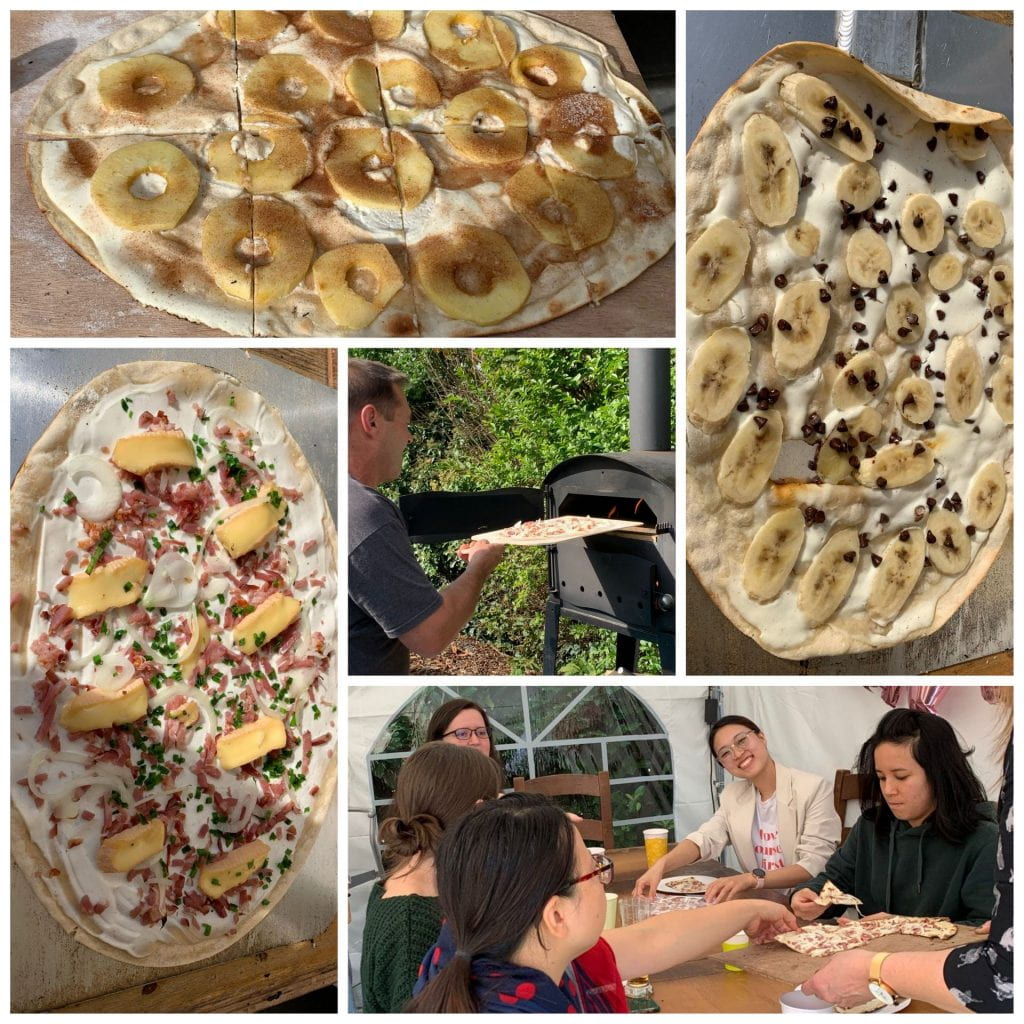Flammekueche, Neustadt, Religion

About a month after arriving in Strasbourg, I was invited to the home of an Alsatian family from the international church that I attend (Trinity International Church of Strasbourg). Myself and other students from the church were very well fed that day – the Alsatian way. Throughout the afternoon, we ate an unhealthy (though definitely delicious) amount of an Alsatian specialty called Flammekueche (or “Tarte Flambée” in French). Flammekueche is a kind of thin pizza, traditionally covered with cream, onions, and bacon. We were able to taste a large variety of this dish with various types of French cheese (munster, goat cheese) and sweet ones (with apples and bananas) for dessert. This specialty is also part of the cuisine of the German region near Alsace.
As the Alsatian cuisine and language show, there are many things about Alsace that make it unique from the rest of France. The reason for this difference is the fact that the region oscillated multiple times between French and German control. The Alsace region, which makes up the northeastern part of France near the German border, was part of the Holy Roman Empire until it was acquired by France in 1648. But when France lost the Franco-Prussian war in 1871, Alsace was annexed to Germany, then in 1919 after World War I, France took back Alsace. During World War II, Nazi Germany annexed Alsace again, but at the end of WWII with Germany losing the war, Alsace became French.

A memorial statue to those who died in WWI can be found in Strasbourg in an area called the Neustadt (new town), in front of the Palais du Rhin, which had been built for the German emperor in 1889. This memorial depicts a kind of Pietà with a mother holding two sons, one facing east toward Germany and the other facing west toward France – symbolizing the Alsatian soldiers that fought on the German side and on the French side. It evokes the painful situation faced by Alsatians who were made to fight against their own brothers on opposing sides. Also, while Alsace was under German control until 1919, the Alsatian population was forced to learn German and forbidden from speaking French. So when WWI ended and Alsace fell back under French control, almost 90% of the population didn’t understand a single word of French. So when Alsace became French, Alsatians were obligated to learn French in schools.
Undoubtedly this constant oscillation resulted in a mixing of German and French culture in Alsace. However today, a couple generations after the end of the world wars, it seems most Alsatian youth identify more with France than with Germany. I spoke with the daughter of the Alsatian family about this, and she explained that she doesn’t identify as German at all, and that she hated learning German in school. Also, her parents speak different Alsatian dialects, which are more similar to German, but she is unable to fully understand them. She mentioned that no one in her generation learns Alsatian or speaks it, especially since it is not taught in school. I later met another Alsatian friend in the Korean class where I do my internship, and she told me, jokingly, that Alsatians don’t like it when people say Alsatian is similar to German. This could signify the tension Alsatians feel when they are considered to be more “German” rather than French because of their dialect or their culture.
Something that really fascinated me was the fact that both of the Alsatian friends I met were Protestant Christians (whereas most of France is traditionally Catholic) and they were very interested in Korean culture. I was able to share with them my own experience growing up with a dual identity (Korean and American) and as a Protestant Christian. The law on religion in Alsace makes it unique from the rest of France, as the 1905 principle of laïcité (strict separation of Church and State) does not apply in Alsace. This law was signed when Alsace was under German control, so when Alsace was returned to France, it remained under the 1801 law of the Concordat. In consequence, in Alsace, four main religions are recognized (Catholicism, Lutheranism, Reformism and Judaism), religious education is compulsory (though families can request to be opted out), and the University of Strasbourg is the only university in France with faculties of theology for Catholicism and Protestantism (Wikipedia). Finally, Christmas is a huge celebration in Alsace and the German regions nearby, with Strasbourg being considered the Christmas capital of the world. The Christmas markets open in Strasbourg next week, so I’ll share photos of them in my next post!
